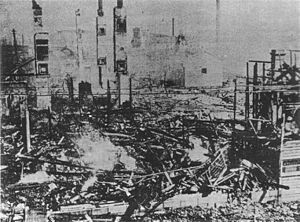Rice Riots of 1918 facts for kids
The Rice Riots of 1918 (米騒動, kome sōdō) were a series of protests in Japan. Many people in Japan were very upset and showed their anger against the government. These events happened between July and September 1918. The riots were so big that they led to the end of the government led by Prime Minister Terauchi Masatake.
Why the Riots Started
The main reason for the riots was a huge increase in the price of rice. Rice was the most important food for people in Japan every day. This price jump caused serious money problems for many families.
The problem was especially bad in the countryside. Farmers were angry because they earned very little money for growing rice. But the rice merchants and the government were selling it for a much higher price. People felt that the government and merchants were letting the price of rice get too high.
This happened right after World War I, when prices for many things, like food and rent, were already rising fast. This made life very hard for Japanese families. Things got even worse because of something called the Siberian Intervention. The government bought a lot of rice to feed its soldiers who were fighting outside Japan. This made the price of rice go up even more. The government did not do much to stop these rising prices, and soon the anger spread from the countryside to towns and cities.
What Happened During the Riots
The Rice Riots were the biggest and most widespread protests in Japan's modern history. They also involved a lot of anger and some violence. The first protest began in a small fishing town called Uozu on July 23, 1918.
At first, people just wanted to peacefully ask the government for help. But the protests quickly grew much larger. People started to go on strike, take things from shops, and even set fire to police stations and government buildings. There were also some fights.
By the middle of September 1918, over 623 protests had happened. These took place in 38 cities, 153 towns, and 177 villages. More than 2 million people took part in these events. About 25,000 people were arrested, and 8,200 were found guilty of breaking laws. Some people received small fines, while others faced very serious punishments.
After the Riots
Japan's leader, Prime Minister Terauchi, said that he and his government were responsible for the riots. Because of this, he and his entire group of ministers all quit their jobs on September 29, 1918.
Some historians who study this time believe that the riots, and the need for more rice, might have led Japan to expand its control over other countries. For example, after the riots, rice production increased in places like Taiwan and Korea, which were under Japanese rule at the time.
See also
 In Spanish: Disturbios por el arroz de 1918 para niños
In Spanish: Disturbios por el arroz de 1918 para niños


